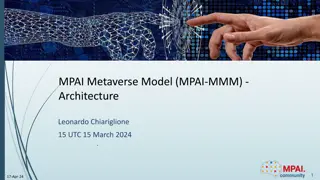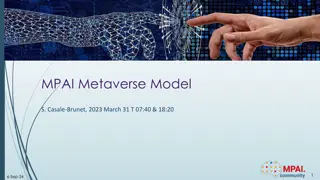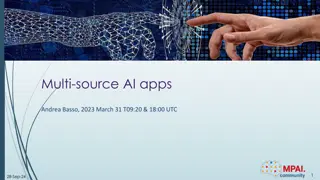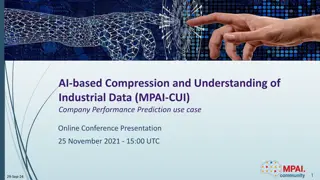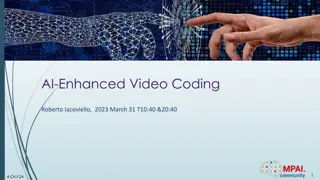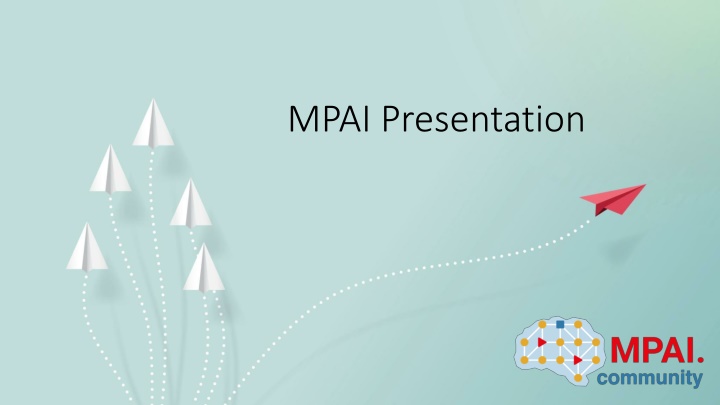
AI-Enabled Data Compression Standards and MPAI: Revolutionizing Technology
Explore how AI-based technologies are transforming data compression standards with MPAI, a non-profit organization focused on developing AI-enabled data compression specifications. Learn about the framework license, MPAI's modus operandi, and the Artificial Intelligence Framework (MPAI-AIF) for efficient data processing and inference workflows.
Download Presentation

Please find below an Image/Link to download the presentation.
The content on the website is provided AS IS for your information and personal use only. It may not be sold, licensed, or shared on other websites without obtaining consent from the author. If you encounter any issues during the download, it is possible that the publisher has removed the file from their server.
You are allowed to download the files provided on this website for personal or commercial use, subject to the condition that they are used lawfully. All files are the property of their respective owners.
The content on the website is provided AS IS for your information and personal use only. It may not be sold, licensed, or shared on other websites without obtaining consent from the author.
E N D
Presentation Transcript
The issues Media compression standards have enabled many businesses, but the traditional technology momentum is slowing AI-based technologies offer more than traditional technologies, also for other data than audio and video, and are supported by a global research effort Licensing of technologies for data compression standards is a major issue for the industry What is MPAI A non-profit, unaffiliated association established on 30/ 09/2020 to develop AI-enabled data compression specifications with clear IPR licensing frameworks. Who is in MPAI Currently 33 members: companies and organisations from 15 countries with broad industry/research coverage
MPAIs modus operandi Acr UC Name Description Collect/aggregate use cases in cohesive projects applicable across industries Identify functional requirements the standard should satisfy Develop and approve the framework licence of the standard Publish a call for technologies supporting the requirements Develop standard in a specific Devel- opment Committee (DC) Complete standard and obtain declarat- ions from all Members Use cases FR Functional Requirements Commercial Requirements Call for Technologies Standard development MS MPAI standard CR CT SD Transitions from a stage to the next stage are approved by the General Assembly
What is a Framework Licence? A FWL is the business model adopted by SEP holders to monetise their IP in a standard without values: no $, %, dates etc. Before starting the technical work active members adopt the FWL During the technical work Active members declare they will make available the terms of their SEP licences according to the FWL after the standard is approved when they make a contribution All members declare they will enter into a licensing agreement for other Members SEPs, if used, within 1 year after publication of SEP holders licensing terms Non MPAI members shall enter into a licensing ag- reement with SEP holders to use an MPAI standard
Artificial Intelligence Framework (MPAI-AIF) Enables creation and automation of processing/inference workflows Mixed ML-AI-Data Processing Scalable Avoiding data pipeline jungles Allocating computing resources Running on constrained hardware scenarios of edge AI devices.
Context-Based Audio Enhancement (MPAI-CAE) Uses AI to Improve the user experience In a variety of uses, e.g. entertainment, communication, teleconferencing, gaming, post-production, restoration etc. In a variety of contexts, e.g. in the home, in the car, on-the- go, in the studio etc. ORCHESTRATOR Noise Output Dynamic Noise Cancell. cancellation Voice Recogn. output optimized Audio experience Input Signals Processing Modules Output Selected Recognizable sounds Environment sounds recognition Dynamic Signal Equalization Environment sound processing ORCHESTRATOR
Integrative Genomic/Sensor Analysis (MPAI-GSA) Uses AI to compress/understand the results of experiments combining genomic/proteomic and other data e.g. from video, motion, location, medical sensors for use cases ranging from personalised medicine to smart farming. Orchestrator Machine/statistical learning (MPAI-AIF) External output Processing Component #n Processing Component #1 Processing Component #2 Data Storage I/O subsystem API Index Processed genomics data Processed sensor data Primary data (sensor source #1) (MPEG video?) Primary data (sensor source #2) (other data) Primary data (genomics source #1) (MPEG-G?) Primary data (genomics source #2) (MPEG-G?) Experiment metadata
AI-Enhanced Video Coding (MPAI-EVC) Uses AI to substantially enhance the performance of a traditional video codec by improving or replacing traditional tools with AI- based tools. 9 Coder Control 8 Down- Sampling Transform & Quantizati on 4 5 Entropy Coding Coded Bits Input Video 5 Dequant. & Invers Transform 1 Luma Intra Estimation 1 AI Intra-Picture Prediction 2 AI Cross-Channel Prediction Chroma Intra Estimation 3 2 AI Inter-Picture Prediction 8 Up- AI Probability Distribution Predict. 4 Sampling 5 1 AI Transform Intra Prediction 6 AI In-Loop Filtering 6 7 In-Loop Filters 3 AI Post-Loop Filtering Inter Prediction 8 AIDown and Up-Sampling 9 AI encoding optimization 10 Motion Estimation 10 AI Motion Estimation 7 Post-Loop Filters Output Video
Server-based Predictive Multiplayer Gaming (MPAI-SPG) Uses AI to minimise AV and gameplay discontinuities caused by high latency/packet losses in online real-time gaming. If info from a client is missing, data collected from clients involved in a game are fed to an AI-machine that predicts the missing moves of the client. Traditional Online Gaming Cloud Gaming MPAI-SPG MPAI-SPG Data Stream Video stream MPAI-SPG
Multi-modal conversation (MPAI-MMC) Uses AI to enable human-machine conversation that emulates human-human conversation in completeness and intensity. text Language understanding emotion Text meaning reply Multi- modal Input Output voice emotion Emotion recognition Speech recognition Dialog processing Final emotion Speech synthesis Text Speech emotion image image analysis Knowledge Base Encycl opedia patent s laws
Multi-modal conversation (MPAI-MMC) Uses AI aims to compress and extract key information from the flow of data produced by companies and external data Company (Internal data) Company output AI machine output Intermediate format Data converter AI machine External data External DB/ Service providers
Join MPAI community www.mpai.community


